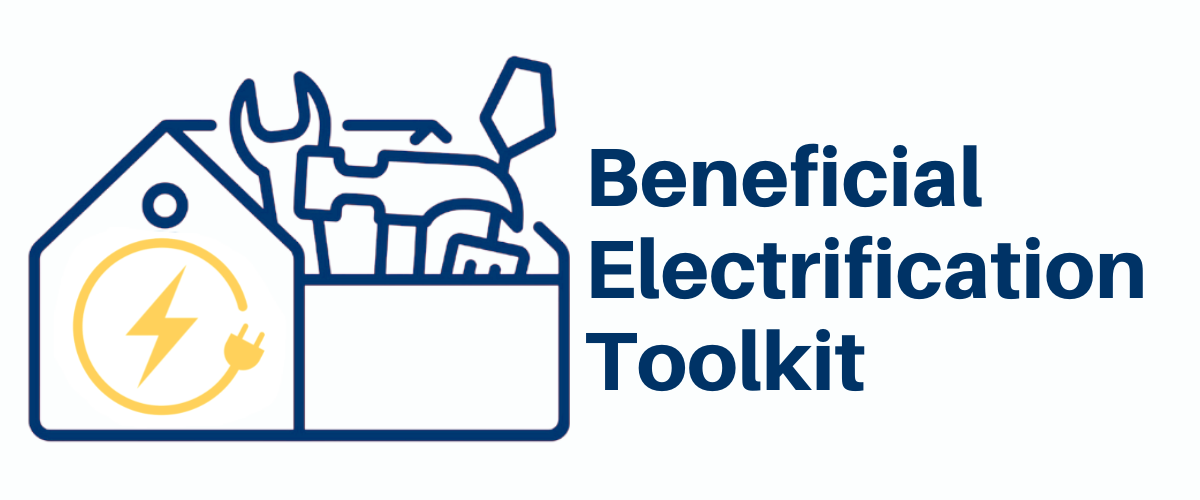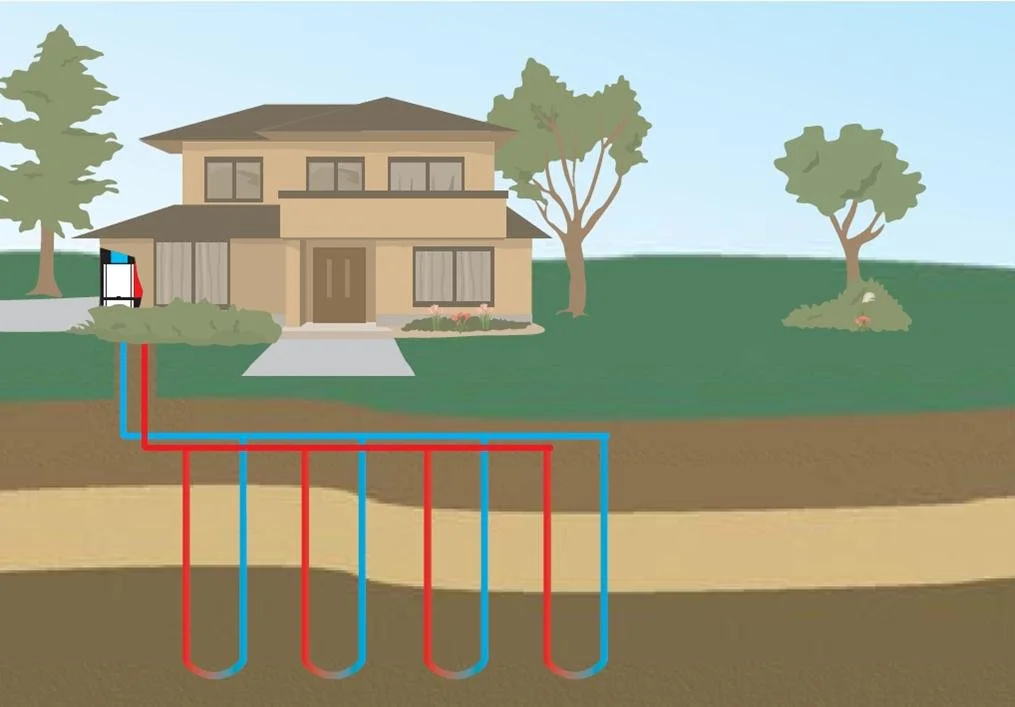
Building Electrification
Ground Source Heat Pump
Ground source, or geothermal heat pumps can out perform other heat pumps as well as furnaces with superior efficiency and are taking hold across the country from the southwest to the northeast.
Reliable Temperature
Horizontal formation of geothermal pipes
When it comes to heating our homes, we know that where we source our heat from matters. As noted in previous pages on the Toolkit, air source heat pumps are a great choice for space conditioning as they provide efficient warming or cooling needs.
However, pulling warmth out of air that fluctuates greatly in temperature can be less than ideal. This is where ground source heat pumps shine.
Consider this: You are trying to heat a room to a comfortable 70 F when the ambient outside temperature is 40 (or 100 F). This is a wide temperature bridge. Now, consider that the ground stays at a constant temperature throughout the year (a few feet below grade), this temperature bridge has been greatly reduced. These benefits grow the wider the temperature differentials are and show up in overall energy used and of course, cost.
A ground source heat pump, like an air sourced unit, still relies on using a heat exchanger to pull heat from one medium into another. In this case, the refrigerants and water are pulling heat from the earth and delivering that to an indoor unit to be transferred into warm air, typically distributed through duct-work in a building.
Vertical Boring = Less Space Required
In temperate climates with an existing structure, installing a ground source heat pump could be a major hurdle, not just for the wallet but also for the land area required, especially for a horizontal system.
Ground source systems may be best suited for yet-to-be developed neighborhoods, or those in more extreme climates with larger undeveloped properties.
As of writing, the largest geothermal installation project, completed to date is in Austin, Texas. This ‘geo-grid’ was built to serve 7,000 homes with bore holes reaching as far as 400 feet into the earth.
Ground source heat pumps are worth being considered with a fresh perspective, especially as vertical boring technology is becoming a space saving practice.
Educational Energy
Lincoln Public Schools, Nebraska
Lincoln, the capital of Nebraska, has been home to a standout example in beneficial electrification and ground source heat pumps since 1990’s. Lincoln Public Schools (LPS), serving over 42,000 students, uses the vertical-bore geothermal systems for heating and cooling across more than 24 buildings. This equates to 90% of their total square footage being conditioned by geothermal energy!
LPS uses a vertical geothermal system, with pipes filled with water reaching wellfields 300 feet underground, where the temperature remains at 55°F. The water circulates through the pipes, absorbing heat when needed and bringing it back to the building. When cooling is required, the process reverses, with the water absorbing heat from the building and transferring it into the ground.
This method is efficient because it reduces the reliance on traditional heating or AC systems, saving energy and reducing LPS's carbon footprint. It's also cost-effective, providing long-term savings on utility bills. According to Scott Wieskamp, director of operations for LPS, “It’s night and day when you compare those first geothermal schools’ energy consumption and total cost of energy” against the schools with boilers and chillers. In an interview with Facilities Dive, Wieskamp explains that the geothermal schools’ annual heating and cooling costs come to about 70 cents per square foot compared with about $1.50 per square foot at the two schools running on traditional HVAC systems.
Over in New York state, Cornell University has completed a nearly two-mile-deep exploratory borehole beneath its campus as part of its Earth Source Heat program.
This project was funded by a $7.2 million Department of Energy grant with the goal to research the possibility of engineering a geothermal water reservoir to sustainably heat university buildings. Cornell is continuing to study the viability of earth source heat. This project could transform how the cold Northeastern states consider staying warm in the winter.
Cost Savings
As with air sourced heat pumps, ground sourced also provide regular cost benefits when compared to fossil fuel heating. This is especially true when there are extreme temperatures and there’s a high cost for fossil fuels.
Geothermal heat pumps provide year-round comfort by offering both heating and cooling in a single system, and they have a longer lifespan compared to gas furnaces.
For those looking to reduce their carbon footprint and invest in a sustainable, long-term heating solution, a geothermal heat pump can be an excellent choice.
Supporting heat pump adoption goes beyond rebates.
Find our discussion of on-bill finance (OBF) in greater detail in Section 4: Program Funding.
Market Outlook
Heat pumps continue to bring predictable growth, year on year
Globally, heat pumps are growing more common and cost effective. With an anticipated compounded annual growth rate (CAGR) of 6.6%, ground source heat pumps will be increasingly common in the coming years. By 2024, the market was valued at nearly $8 billion and by 2030 is on track to grow to about $12 billion.
The global heat pump market (including air, water and ground) is expected to keep growing from $86 billion in 2024 and is project to reach $148 billion in revenue by 2030.
Additional Resources
Science Direct: Vertical-borehole ground-coupled heat pumps: A review of models and systems
Lincoln Public Schools: Using geothermal heat to save energy
Facilities Dive: Geothermal heat pumps: 8 factors to consider in commercial buildings
Canary Media: Geothermal heat pumps are crazy efficient. Should you get one?
Habitat For Humanity: An Affordable 48-Home Single-Family Community in Northeast Austin
Research and Markets: $11.4 Billion Geothermal Heat Pumps Market Outlook
Grand View Research: Heat Pump Market Size, Share & Trends Analysis Report By Technology
EESI: Earth Source Heat: Unlocking Geothermal in the Northeast





